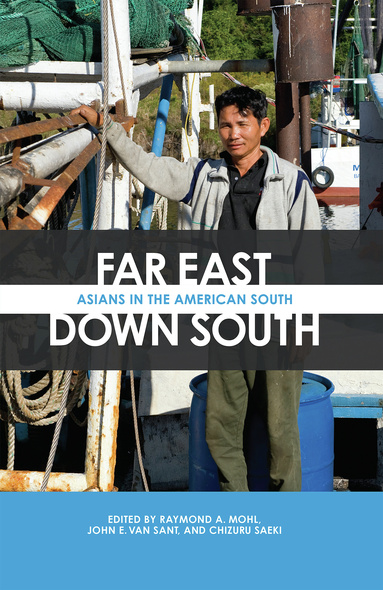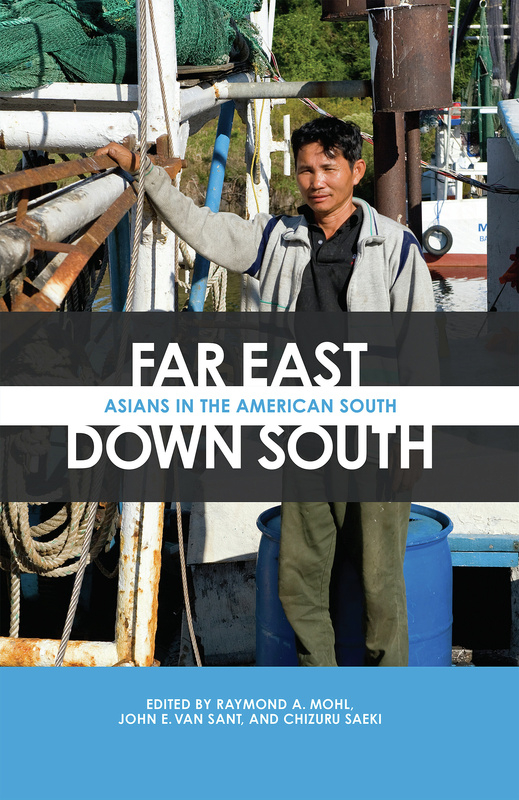
Far East, Down South
Asians in the American South
In sharp contrast to the “melting pot” reputation of the United States, the American South—with its history of slavery, Jim Crow, and the civil rights movement—has been perceived in stark and simplistic demographic terms. In Far East, Down South, editors Raymond A. Mohl, John E. Van Sant, and Chizuru Saeki provide a collection of essential essays that restores and explores an overlooked part of the South’s story—that of Asian immigration to the region.
These essays form a comprehensive overview of key episodes and issues in the history of Asian immigrants to the South. During Reconstruction, southern entrepreneurs experimented with the replacement of slave labor with Chinese workers. As in the West, Chinese laborers played a role in the development of railroads. Japanese farmers also played a more widespread role than is usually believed. Filipino sailors recruited by the US Navy in the early decades of the twentieth century often settled with their families in the vicinity of naval ports such as Corpus Christi, Biloxi, and Pensacola. Internment camps brought Japanese Americans to Arkansas. Marriages between American servicemen and Japanese, Korean, Filipina, Vietnamese, and nationals in other theaters of war created many thousands of blended families in the South. In recent decades, the South is the destination of internal immigration as Asian Americans spread out from immigrant enclaves in West Coast and Northeast urban areas.
Taken together, the book’s essays document numerous fascinating themes: the historic presence of Asians in the South dating back to the mid-nineteenth century; the sources of numerous waves of contemporary Asian immigration to the South; and the steady spread of Asians out from the coastal port cities. Far East, Down South adds a vital new dimension to popular understanding of southern history.
Now that there is a substantial population of Asians in the South, it is high time for a volume of this nature. This book will serve a pioneering role by introducing a new and expanding field in Asian American studies that breaks out of the West Coast paradigm and stimulates further research.'
—Wayne Patterson, author of The Korean Frontier in America: Immigration to Hawaii 1896–1910
'Collectively, the essays make a compelling argument for a distinctive Southern Asian American history for early to mid-twentieth-century Chinese and Japanese Americans: an ‘in between’ status of honorary and probationary whites who enjoyed some white privileges while pursuing ethnic-niche businesses that underlined the immigrant generation's lack of access to full mobility.'
—Lisa Rose Mar, author of Brokering Belonging: Chinese in Canada’s Exclusion Era, 1885–1945
One of the most notable facets of immigration to the US in recent history has been the new destinations phenomenon—the settlement of new arrivals in locations outside the traditional immigrant concentrations in the northeast and west coast. The southeast has been one of these new destinations, and the region has drawn substantial numbers of the nation's fastest growing category of immigrants, Asians. As the nine essays in this volume point out, however, the newness of Asian immigrants in the southeast is largely a matter of greatly increased numbers. Several of the states considered in this book have been home to small groups of Asians for a long time. The editors have put together an excellent set of studies on different Asian nationalities in a variety of states. Highly recommended.’
—CHOICE
John E. Van Sant is the author of Pacific Pioneers: Japanese Journeys to America and Hawaii, 1850–80, the editor of Mori Arinori's Life and Resources in America, and a coauthor of Historical Dictionary of United States–Japan Relations.
Chizuru Saeki is the author of US Cultural Propaganda in Cold War Japan: Promoting Democracy 1948–1960.
List of Illustrations
Preface
Introduction
David M. Reimers
1. The Astonishing History of Japanese Americans in Louisiana
Greg Robinson
2. Views of Japanese in Alabama, 1941–1953
Chizuru Saeki
3. Collective Aspirations of Japanese Americans in and beyond the WWII South
John Howard
4. Asian Immigration to Florida
Raymond A. Mohl
5. Chinese in Florida: History, Struggles, and Contributions to the Sunshine State
Wenxian Zhang
6. “Chinese for the South”: Mississippi Delta Chinese Migration Chains
John Jung
7. Second-Generation Chinese Americans from Atlanta, Augusta, and Savannah Georgia: Overcoming “Otherness”
Daniel Bronstein
8. Immigrant Dreams and Second-Generation Realities: Indian Americans Negotiating Marriage, Culture, and Identity in North Carolina
Vincent H. Melomo
9. Resilient History and the Rebuilding of a Community: The Vietnamese American Community in New Orleans East
Karen J. Leong, Christopher A. Airriess, Wei Li, Angela Chia-Chen Chen, and Verna M. Keith
Contributors
Index





